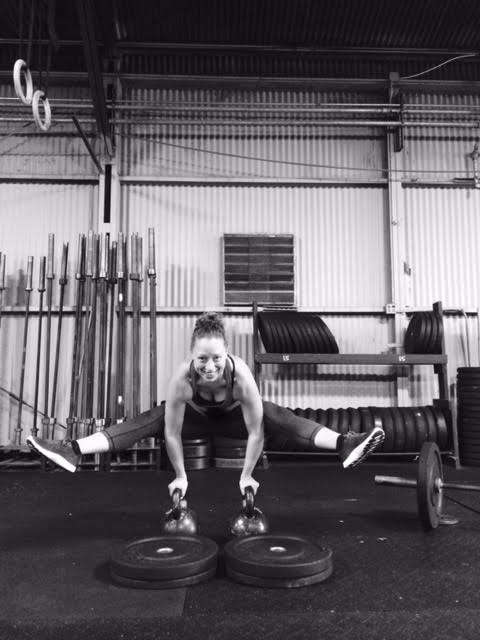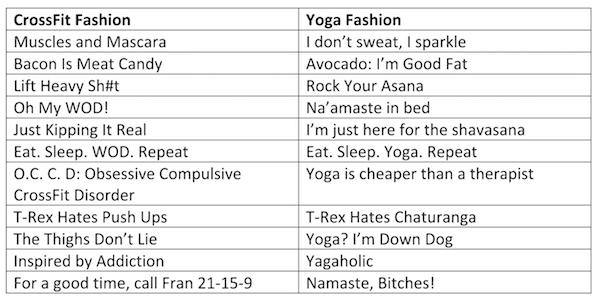
In 1998, I discovered yoga as a teenager in small-town Pennsylvania. I had a few VHS tapes that I would do alone in my parent’s living room.
Since then I’ve gone on to develop a consistent personal practice, do lots of yoga teacher trainings, and also co-own a successful yoga teacher training business as well as delve deeper into the myriad of “beyond the physical” benefits of a regular yoga practice.
In my early 30s, something started to physically shift for me. My lower back hurt and my hips ached. I started to realize that my body had become too flexible, too mobile, without enough strength and stability to counter balance. My body was a collection of mobile joints that looked outwardly fit but were becoming less functional and more painful. So I did a little research and started going to a gym.
I spent a few years in various gym settings but never found quite the right one for me. I had heard all of the hype about CrossFit—had seen the videos that mock their fast-moving work out style and read articles about the terrible ways people injured themselves while doing Crossfit but still, I was curious.
So about eight months ago (and about five to six years in to my gym-sploration) I signed up for a one month introductory course at a local CrossFit gym on a recommendation from a friend.
On day one I walked into what looked like organized chaos.
It was summertime in Florida in a garagey-wharehouse (read: no air conditioning) type of building. There were scores of sweaty, fit people doing all manner of things that looked impossible. Some people were hanging from the central monkey bars and flinging their lower bodies up to the bar. Others were picking up barbells with an extraordinary amount of weight on them and doing some complicated things with their arms and legs, and eventually hoisting the bars (loaded with weight plates) overhead—again, and again. Yet others were performing some crazy jump rope voodoo and some were somehow strapped into an apparatus by their ankles that allowed them to do a full range of motion sit-up that looked both fun and gravity-defyingly terrifying at the same time. All at once a voice boomed “three, two, one, time!” and everyone collapsed into a much-deserved savasana (resting pose done after a yoga practice) right where they stood.
There were only three of us in the intro group, and the “coaches” (class instructors) of the gym took turns training us in all of the fundamental movements of CrossFit three times a week that month. We learned the movements and had mini workouts that utilized our new skills.
Oh boy, was that a humbling month! I was reminded of what it must feel like for my beginning yoga students to be coached through their first sun salutation. Those movements that feel so natural, so ingrained, so simple to my body are bewitching and confounding to new students. Now the roles were reversed.
The PVC pipe and I attempted many a graceless clean and jerk (a complicated weight lifting movement) and many an awkward deadlift (a less complicated but still tricky weight lifting movement). The “monkey bars”—properly known as “the rig”—and I did battle in the arena of failed pull-ups and flailing toes to bar and the ever-patient coaches repeated themselves and demoed the same movements over and over again, as my brain and body attempted to learn new movements.
Soon, the intro month was over and it was time to join the “real” classes with “real CrossFitters.” Our intro sessions were small and at odd times, so I didn’t get a real sense of the culture until that second month. Here are some observations about the similarities and difference between the yoga world and the world of CrossFit.
Similarities:
1. Community.
It was very clear to me early on that the gym—or “box”—as they are known, is a place where its members like to be. The thriving yoga studio where I am fortunate enough to teach and practice, has the same vibe each evening.
People come in from their work day, often harried, fresh out of traffic, eager to shed their work clothes, get into something comfy and move their bodies, or rest their bodies—most often both. There is a sense of homecoming almost, and I always feel privileged and grateful to play a role in holding that space for their self-care, their recharge. It’s a place where students and teachers know each other by name, where we ask about a student’s recent vacation or knee surgery, congratulate a recent college grad and offer condolences at the loss of a loved one. There is a real sense of community and a healthy dose of levity.
I got the very same impression from the CrossFit gym. People are glad to be there and glad to see each other. People of all ages, backgrounds and abilities chat easily as they slither around on foam rollers before class. The sense of community that comes from a group of diverse and good-natured people with common goals is palatable.
I believe we are drawn to community building in many ways and movement disciplines are no exception. Could we each run around the block a few times, pick up some heavy things, and do some sit ups on our own? Yep we could. Could we use a book or video or spontaneously create our own asana sequence to do in our living rooms? Most certainly. And many do just that, but one of the reasons gyms and yoga studios of any kind exist is because there is power and magic in the group experience. Barbell Sangha—that would make a good t-shirt slogan for my fellow yogi CrossFitters. More on shirt slogans later.
2. Support.
Perhaps a natural outgrowth of community building is that its members offer support to one another. No doubt it “looks” different in the yoga world versus the CrossFit world, but it boils down to the same goal: to encourage, to support—whatever the goal is. When I’m teaching yoga that materializes as creating a really safe space for students to listen to their bodies.
Admittedly, the MO in CrossFit is more often than not about dialing it up. For example, when someone has some heavy weight across their shoulders and is struggling to stand up from the bottom of a back squat, CrossFitters seem to have a sixth sense about this because everyone in the place, from the folks doing the workout to the people hanging out putting on their shoes or taping their fingers, can sense the need for an extra push; a chorus of “up, up, up,” emanates from every mouth—and by golly it works 99 percent of the time! The red faced back squatter manages to stand up straight under the heavy weight, stagger to rack the barbell and an enthusiastic celebration ensues!
This is how I feel when I am coaching someone through a backbend or headstand or when I help them find a chaturanga modification that suits them perfectly—it’s exciting, and I usually (annoyingly) yell “Yay! That’s it!” and we all beam!
But I must say that it’s not all about mindlessly dialing it up in CrossFit, as I think is often its reputation. I can remember one particularly hellish thruster-centric workout. The gal beside me was obviously struggling. Then the coach came by and asked her, “Where does it hurt?” She breathlessly grunted and gestured to her low back. “Okay, stop. Take a rest for a few, then give me a nice long cobra pose.” Boom!—a healthy dose of viveka (keen discernment) right in the middle of the WOD (that is CrossFit speak for Work out of the Day). Ah, I love when my worlds synthesize!
And of course the pre-WOD instructions always include ways to “scale” (think modifications/prop use in asana practice) the movements. Can’t do pull ups? No prob! Grab a box so you can jump up and recruit your lower body! Not ready for the suggested 125 pounds for the weight lifting aspect of the WOD? Put less weight on the bar, or heck, grab a training bar and use even less weight so the technique can be mastered first! You get the idea—exactly the same concept as using blocks and straps in asana: we modify, we make successive approximations, we make the shape of the pose along the way to mastery, whether it’s in this lifetime or the next.
3. The Zone.
Both CrossFit gyms and yoga studios can feel intimidating to the uninitiated. But newbies of both disciplines quickly learn that once things get started, whether it’s a WOD or an asana practice, everyone gets into their own zone and does their own thing. I like that both CrossFit and public yoga classes offer the aspect of community without necessarily collaboration—save partner WODs or partner yoga—but on the whole, in both endeavors, everyone is in their own zone, squaring off with whatever is coming up in the body and in the mind.
Nobody knows or cares who is deadlifting 165 lbs. or 365 lbs.; nobody cares who is choosing child’s pose over forearm stand. Either way we are buoyed by the group energy but at the same time left to get into our own zone. And as yoga practitioners and CrossFitters alike are aware, when we tune into the body we tune into presence, to focus. When we improve the way the body functions we create conditions to become aware of how the mind functions. Patanjali didn’t list asana as limb number three at random—the body is a gateway to so much more!
And of course there are a few differences:
1. Fashion.
At first glance, CrossFit wear is not that much different from what we see in a typical yoga class. Similarly snug pants or shorts and tanks or Ts are common in both disciplines, but look a little closer and you’ll see some key differences. Here’s a handy chart of shirt slogan differences for your reference:

2. Pre and Post Class Snacking:
At CrossFit, it’s all about shaker bottles full of all manner of powdery goodness added to water for charging up before a workout and helping the body recoup after. Some caffeine, some creatine, some BCAAs—all in a delicious drink that tastes like watermelon or pink lemonade. The shaker bottles are ubiquitous and the technique is unmistakable: index finger over the lid for added security, followed by a vigorous one handed shake—unsurprisingly, the technique is all in the wrist.
At the yoga studio you’re more likely to see coconut water, kombucha, or a good old fashioned jar of homemade green juice for before and after class nourishment; sometimes a handful of almonds or a piece of fruit. Now don’t get me wrong, it’s not always an endless parade of kale and heirloom apples in the yoga world. We can plow through a huge jar of jelly beans and are far from opposed to the occasional birthday cupcake or cookie.
Conclusion:
I am in month eight of my CrossFit journey, and by all accounts am a novice at best. I have learned a few things since day one:
The clean and jerk still mystifies me a bit, but less so than on day one when I stood mesmerized watching the class doing them before my first intro session. There are so many ways one can hang from a bar and attempt a challenging movement that looks so simple! It took me six months to get “toes to bar,” maybe pull ups are next?!
The jump rope voodoo I witnessed on day one are called “double unders.” Crossfitters turn the rope twice for every one jump. So far my record for consecutive double unders is…wait for it…one. No place to go but up! The gravity-defying, full range of motion sit-up apparatus is called the GHD: the glute hamstring developer. No kidding! Ankles in, butt on, torso in the air! No choice but some serious glute, hamstring, and ab work.
In the end, I am enjoying learning so many new ways to move my body. I have long since shed the feeling of being an asana practitioner failure because I use weight lifting and cardio/endurance training to care for my body. The perfect day for me starts with meditation, then CrossFit, includes some work in the middle, and ends on the yoga mat. Ah, balance.
~
Author: Stacey Abbott
Image: Author’s Own
Apprentice Editor: Elizabeth Gottwald; Editor: Catherine Monkman











Read 12 comments and reply